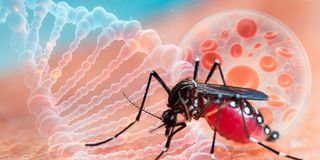Why malaria risk has increased in northern Kenya

Risk levels have tripled or quadrupled due to increased rainfall, higher temperatures and land-use changes that have created ideal breeding conditions for mosquitoes.
What you need to know:
- New study highlights the need for targeted malaria strategies that take into account seasonal and climatic variations.
- Report shows that Kenya saw a promising decline in malaria prevalence from eight to six per cent over the period.
Climate factors such as rainfall and temperature are reshaping the spread of malaria in Kenya, according to a new study by the Kenya Medical Research Institute and the Swiss Tropical and Public Health Institute (Swiss TPH).
The study, 'The influence of malaria control interventions and climate variability on changes in the geographical distribution of parasite prevalence in Kenya between 2015 and 2020', found that malaria risk has increased sharply in northern regions such as Turkana, where risk levels have tripled or quadrupled due to increased rainfall, higher temperatures and land-use changes that have created ideal breeding conditions for mosquitoes.
The report shows that Kenya saw a promising decline in malaria prevalence from eight to six per cent over the period, particularly among children. For children under five, the reduction was 31 per cent, and for children aged five to 14, it was 26 per cent. For younger children, there was a 50 per cent reduction in low-risk areas, but a 41 per cent increase in semi-arid areas. For older children, the risk of malaria increased by 83 per cent in low-risk areas and by 100 per cent in semi-arid areas.
"By applying advanced geostatistical models to national malaria surveys from 2015 to 2020, we found that while malaria rates declined overall, malaria risk increased in certain regions, particularly in northern Kenya. These findings highlight the urgency for public health systems to rapidly adapt to changing environmental conditions," said Bryan Nyawanda, scientific officer at the Swiss TPH.
These findings reflect the effectiveness of malaria control interventions such as insecticide-treated nets (ITNs), indoor residual spraying (IRS) and antimalarial drugs.
The lake endemic zone, with a prevalence of 26.6 per cent in 2015, showed a decrease in parasitaemia by 2020 in the lake, coastal and highland zones. However, an increase was observed in semi-arid zones (from 0.5 to 1.8 percent) and low-risk zones (from 0.3 to 0.4 percent).
"The overall reduction in malaria is encouraging, but the increase in certain regions shows how unpredictable the effects of climate change can be," said Penelope Vounatsou, head of Biostatistics at the Swiss TPH, highlighting the need for more localised strategies to address these emerging challenges.
The findings, published in the International Journal of Health Geographics, also examined the impact of urbanisation on malaria and found that areas with increased development (indicated by brighter night lights) had lower malaria rates due to improved infrastructure, reduced exposure to mosquitoes and better access to healthcare. The previously strong correlation between increased rainfall and malaria in 2015 had weakened by 2020, highlighting the growing importance of urbanisation alongside traditional control measures.
The findings highlight the need for targeted malaria strategies that take into account seasonal and climatic variations. While overall malaria prevalence has declined in Kenya, increasing risks in low-risk and semi-arid regions show that continuous surveillance and regional interventions are crucial.
Similarly, traditional tools such as ITNs and seasonal chemoprevention should be combined with newer methods such as spatial repellents and advanced insecticides to protect vulnerable areas.
As climate patterns evolve globally, Mr Nyawanda suggests that other countries facing similar challenges could use geostatistical models to better understand malaria trends and design tailored responses. This research provides a roadmap for addressing the interlinked challenges of malaria and climate change.
"The shifting climate requires innovative solutions. By understanding the interaction of environmental and socio-economic factors, we can better allocate resources and adapt strategies to shield high-risk populations," said Mr Nyawanda.
Malaria, one of the world's deadliest disease spread primarily by Anopheles mosquitoes, remains a major health challenge in sub-Saharan Africa, with an estimated 249 million cases and 608,000 deaths in 2022.
The World Health Organization's (WHO) African region accounts for 94 per cent of cases and 96 per cent of deaths worldwide.
In Kenya, pregnant women and children under the age of five are at the highest risk of contracting malaria. Malaria accounts for 13 to 15 per cent of outpatient visits, with about 70 per cent of the population at risk. The Plasmodium falciparum parasite causes 96 to 99 per cent of infections.
Climate change is expected to exacerbate the spread of malaria, with more than five million cases reported annually, affecting previously unaffected regions.
Global efforts are underway to reduce malaria. In 2015, the World Health Assembly adopted the Global Technical Strategy for Malaria (2016-2030) to reduce malaria incidence and deaths by 90 per cent by 2030. In 2017, WHO recognised that progress on the GTS was off track, and in 2018 launched the High Burden to High Impact (HBHI) approach with the Roll Back Malaria partnership. HBHI supports 11 high-burden countries to reduce malaria and achieve the GTS 2025 targets.
In Africa, the African Union launched the Zero Malaria Starts with ‘Me campaign’ in 2021 with the goal of eliminating malaria by 2030. Kenya's 'Kenya Malaria Strategy 2019-2023' aims to reduce malaria incidence and deaths by 75 per cent by 2023 from 2016 levels.
The success of these strategies depends on the optimal use of effective vector control tools, climate and environmental variability, community awareness, strengthening of National Malaria Control Programmes and public relations, experts say.

